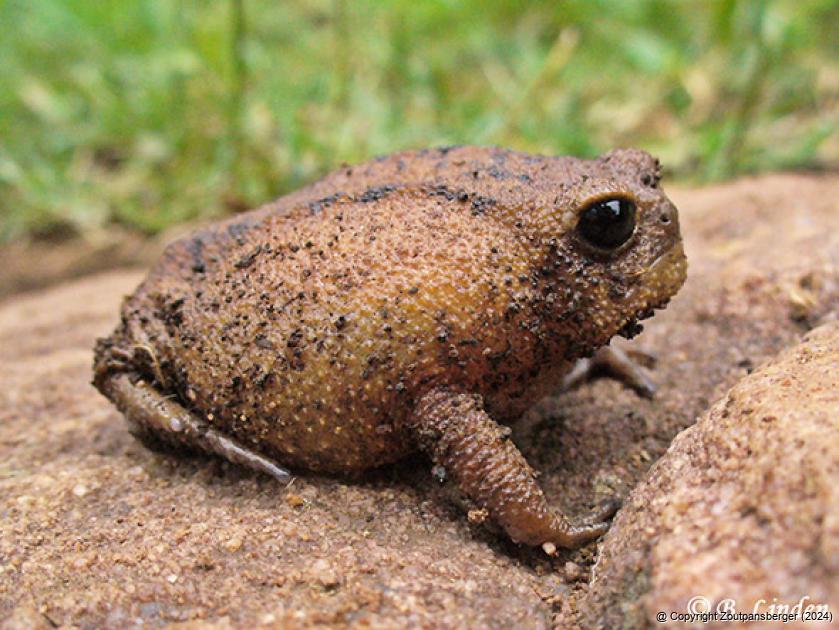

ADVERTISEMENT:

Breviceps sylvestris taeniatus - Forest Rain Frog
(Photo: B. Linden)
Become a Vhembe citizen scientist
Date: 16 January 2015 By: Isabel Venter
What do Venda Forest King Emperors, Soutpansberg Dwarf Geckos, Lajuma Jumping Spiders, Soutpansberg Grass Aloes and Venda Bushwillows all have in common?
They are all species that are found only in the Vhembe Biosphere Reserve (VBR) and nowhere else on earth.
Moreover, their Latin names honour people and places associated with the VBR, which underlines the spectacular uniqueness and richness of the biodiversity of the region. No fewer than 57 plant species and 39 animal species are endemic to the VBR and this figure will increase as more species, particularly of insects, are discovered in the near future.
The VBR spans 30 000km2 over the northern part of the Limpopo Province, supports 1.5 million inhabitants and is a globally recognised centre of endemism, biodiversity and cultural importance. During 2009, the VBR was inscribed as such by UNESCO’s Man and Biosphere programme.
At the core of the VBR is the Soutpansberg Mountains, which contain between 2 500 and 3 000 species of plants that belong to 1 000 genera - more genera than even the world-famous Cape Floristic Kingdom has.
The Mapungubwe World Heritage Site also falls within the VBR, as does the northern part of the Kruger National Park, and more than 1 000 rock-art sites are known from the Makgabeng Plateau.
Together, this unparalleled biodiversity provides a critical ecosystem service to the community - especially rural communities that still rely directly on nature for their livelihoods. If the delicate scales on which the VBR rests are tipped into destruction, the life-support system on which humans rely, could be irreversibly damaged.
That is why core and buffer areas are a necessity. Core areas are typically “no-go areas” for development in order to preserve the biological diversity and cultural value. Lower-impact but sustainable land uses are still permitted in the buffer areas, though.
Currently, the VBR lacks a coherent spatial network of core and buffer areas that accurately reflects the distribution of critical biodiversity and ecosystem services. Therefore the Department of Environmental Affairs has commissioned, in collaboration with the University of Venda, an Environmental Management Framework (EMF) to take place this year.
The primary goal of the EMF will be to map out the core and buffer areas of the VBR to guide sustainable development in the region.
This EMF initiative will be supported by an informal working group of passionate researchers and students from the University of Venda’s new South African Research Chair on Biodiversity Value & Change in the Vhembe Biosphere Reserve, working together with the Vhembe Biosphere Reserve Committee and ecologists and planners from the Limpopo Department of Economic Development, Environment and Tourism (LEDET) and the Vhembe District Municipality.
The working group, termed “Mapping Vhembe”, has already begun to compile information on the distribution of threatened and endemic plants and animals within the VBR.
The Mapping Group, as they have come to be known informally, has appealed to readers to become involved with their study and become a citizen scientist. To find out more about the region, to be better informed about developments where public comment is needed, and how to contribute as a citizen scientist to various projects to map and understand the local flora and fauna, readers can visit the recently launched website of the Research Chair on Biodiversity Value & Change (www.vhembebiosphere.org/sarchi/).
Viewed: 1817
|
|
Tweet |

-

Former Triegie’s acting career taking off
12 April 2024 By Karla van Zyl -

'Temporary fix is safe, but do not touch cables,' says municipality
12 April 2024 By Andries van Zyl -

Another R2 million pumped into broken pool
12 April 2024 By Andries van Zyl -

Louis Trichardt se rugbymanne wys reeds vroeg in die seisoen tande
12 April 2024 By Andries van Zyl -

Havinga waarsku teen koue en droë winter
11 April 2024 By Andries van Zyl

Isabel Venter
Isabel joined the Zoutpansberger and Limpopo Mirror in 2009 as a reporter. She holds a BA Degree in Communication Sciences from the University of South Africa. Her beat is mainly crime and court reporting.

More photos...

Zoutpansbergia cerulea - Nyatsi (Tshivenda). (Photo: B.Linden)

Vangueria soutpansbergensis - Soutpansberg medlar. (Photo: B.Linden)

Pavetta trichardtensis - Bride's bush (Photo: B.Linden)

Combretum vendae var glabrata - Combretum vendae var glabrata (Photo: B. Linden)

Aloe hahnii - Hahn's aloe (Photo: B. Linden)


ADVERTISEMENT


-

Park development leaves residents puzzled
22 March 2024 By Andries van Zyl -

Local para-athletes shine at SA Champs
05 April 2024 -

Epic finish for local cycling duo
29 March 2024 By Andries van Zyl -

What next Vhembe!
22 March 2024 By Andries van Zyl -

Debt-collection company apologises for rude letter
29 March 2024 By Anton van Zyl

ADVERTISEMENT:


ADVERTISEMENT


